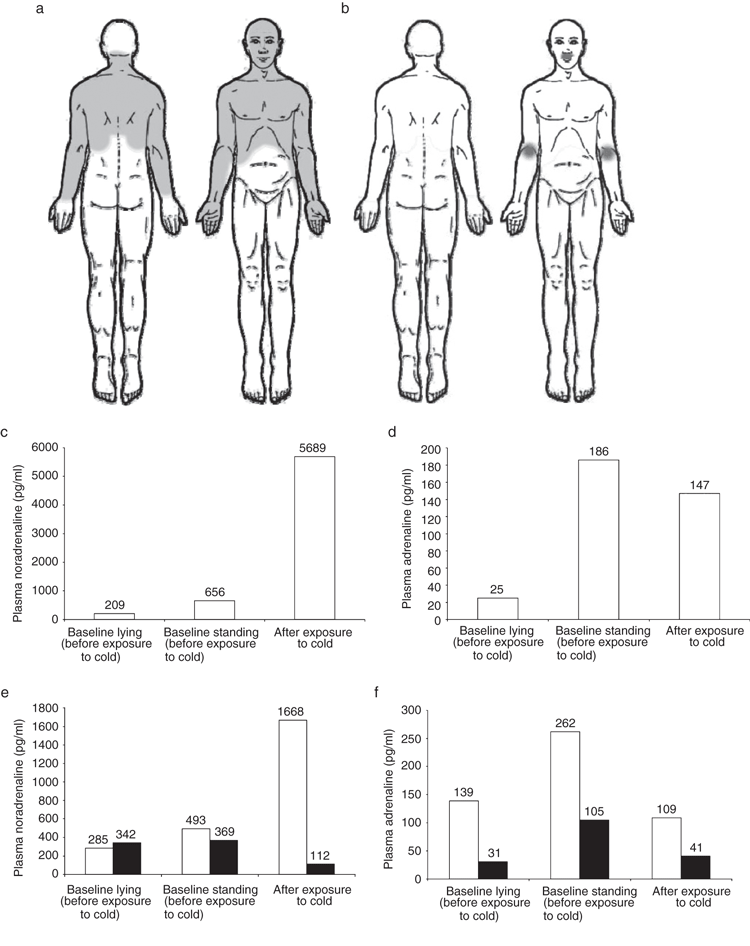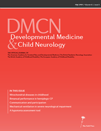Successful treatment of cold-induced sweating in Crisponi syndrome and its possible mechanism of action
SIR–Crisponi syndrome (MIM #601378) is a rare severe infantile autosomal recessive disorder characterized by paroxysmal contractions of the facial muscles, hyperthermia, feeding difficulties, and camptodactyly.1 Hyperthermia frequently leads to death within the first months of life, whereas the rare surviving patients develop scoliosis, psychomotor retardation, and cold-induced sweating.2 The syndrome is caused by mutations in the cytokine receptor-like factor 1 (CRLF1) gene,2,3 mutations of which have also been associated with cold-induced sweating syndrome (CISS; MIM #272430),4 and it can be hypothesized that these two syndromes reflect different manifestations of the same entity.2,3 We present two Turkish siblings with Crisponi syndrome, in whom cold-induced sweating associated with excessive noradrenaline release was effectively treated with moxonidine, a centrally acting imadozoline receptor agonist. The parents consented to the publication of this report.
The male patient was born as the third child of consanguineous parents originating from Eastern Turkey.2 The first child of the family died 21 hours after birth of respiratory distress; four other siblings are healthy. The patient was born at 40 weeks’ gestation after an uneventful pregnancy, with Apgar scores of 10/10 at 5 and 10 minutes respectively.
On initial examination, camptodactyly of the 4th and 5th fingers of both hands was noted. Within the first few weeks of life, he developed recurrent hyperthermia with core temperatures up to 40°C. He exhibited an increased flexion tone of the extremities and truncal hypotonia as well as paroxysmal contractions of the facial muscles. Because of sucking and swallowing difficulties he was fed through a nasogastric tube during the first 10 months of life. Metabolic screening was normal, as was brain sonography and electroencephalography at 1 year of age. The karyotype was 46, XY.
During his second year of life, hyperthermia and feeding difficulties resolved. He learned to walk at the age of 18 months. At 10 years of age he first complained of ‘feeling cold on the back and on the hands’ and of spontaneous sweating attacks on different occasions.
At the age of 14 years profuse sweating of the upper part of the body occurred at room temperature. He was found to sweat intensely and to feel uncomfortable in cold rooms and to feel well at higher ambient temperatures.
The female patient is the younger sister of case 1. She was born at 41 weeks’ gestation. In early infancy, she had feeding difficulties and presented almost identical symptoms and an almost identical clinical course to her elder brother. She was noted to cry with a compressed mouth and increased salivation. She developed a thoracolumbal scoliosis and increased sweating at low ambient temperatures at 7 years of age. She felt more comfortable during hot summer days. Because of increasing scoliosis a dorsal instrumentation was placed surgically.
At the age of 13 years, the diagnosis of Crisponi syndrome was established.
In both patients the mutation c.708–709delCCinsT was found on both alleles of CRLF1, resulting in the frame shift p.Pro238ArgfsX6.2
To visualize areas of sweatening in both probands, an iodine solution (Jodi puri 1.5, Olei ricini 10.0, Spiritus 96% 90.0) was applied before covering the skin with potato starch powder. A violet discoloration of the covered areas was considered positive for sweating.5 In both siblings, at 27°C ambient temperature, only very mild sweating was noted. However, while sitting undressed at 19°C, within 2 minutes intense sweating occurred, starting on the lower arms and spreading to the neck, upper back, shoulders, and upper arms accompanied by piloerection. After 5 to 7 minutes, the entire upper part of the body was sweating (Fig. 1a). Body core temperature dropped by 1°C and heart rate increased by about 20 beats per minute. In the male a 27-fold rise (Fig. 1c), while in the female a 7-fold rise in plasma noradrenaline (NA) levels was registered (Fig. 1e). This increase was excessively greater than the reaction to standing up from a supine position (Fig. 1c,e). In contrast, in both patients, the changes in adrenaline levels were stronger in response to standing than in response to cold exposure (Fig. 1d,f).

Response to low ambient temperature in two adolescents with Crisponi syndrome. Areas of profuse sweating in response to 19°C ambient temperature in (a) case 1 and case 2 before treatment and (b) after moxonidine treatment in case 2. Shaded grey areas reflect sweating. (c) Plasma noradrenaline levels (reference: 185–275pg/ml) and (d) plasma adrenaline levels (reference: 30–85pg/ml) before and after exposure to cold (19°C room temperature), case 1. (e) Plasma noradrenaline levels and (f) plasma adrenaline levels before and after exposure to cold (19°C room temperature), as well as before (white bars) and after treatment with moxonidine (black bars), case 2.
Both probands were treated with the central α2-adrenoreceptor agonist clonidine with a maximum dose of 3μg/kg body weight per day, which resulted in a dramatic decrease of cold-induced sweating within 3 days. Because both siblings felt exceedingly tired during 2 years of treatment with clonidine, the medication was changed to moxonidine with a maximum dose of 6μg/(kg/d), which was better tolerated.
In the female, 14 months after the start of moxonidine only very mild sweating was seen at 19°C ambient temperature on the upper lip and in the elbow flexures (Fig. 1b). Under moxonidine treatment, adrenaline baseline levels were lower than before (Fig. 1f), however, the noradrenaline baseline level was slightly higher than before (Fig. 1e). Conspicuously, there was no significant increase of catecholamine levels in response to cold exposure under treatment; the plasma adrenaline level rose to 132%, whereas the noradrenaline level even dropped to 33% of the baseline level (Fig. 1e,f).
The paradoxical sweating phenomenon in our patients was comparable to the cold-induced sweating described in two Israeli sisters,6 two Norwegian brothers,4 and in a Canadian adult female,7 who were classified as having CISS and carried mutations in CRLF1.4,7 Cold-induced sweating has also been described in an Australian patient carrying a mutation in CLCF1 encoding cardiotrophin-like cytokine (CLC),7 a known binding partner of cytokine receptor-like factor 1 (CRLF1), both ligands to the ciliary neurotrophic factor receptor (CNTFR).2
The noradrenaline release in response to cold in our probands was similar to the reactions described by Hahn et al. for CISS7 and strikingly more exaggerated than the normal human response to cold exposure, which is associated with a 2- to 5-fold increase of noradrenaline levels.8 As in CISS, our patients’ catecholamine reactions to standing were normal, whereas the sympathiconeural system showed hypersensibility and excessive response to cold indicating a defect in thermoregulation. The excess level of noradrenaline could be caused by excess release of noradrenaline by the adrenal glands, or inadequate degradation of the released noradrenaline. One could speculate that the exaggerated noradrenaline response to cold may have induced sweating. This would be supported by the fact that apocrine sweat glands are controlled by adrenergic and circulating catecholamines.9
It is also possible that in our patients some noradrenaline was released into the medial preoptic area thermoregulatory centres, which acted on α1-adrenoceptors present on thermosensitive neurons10,11 and induced hyperthermic response, sweating, resulting in hypothermia.12 Also, it may well be that the α2-adrenoceptors in these patients might have been altered so that their sensitivity to noradrenaline was altered though they remained sensitive to the agonists clonidine and moxonidine. The latter may be supported by the findings that the affinity and active sites of at least the α1a-adrenoceptor differ for noradrenaline (natural ligand) and that of its agonist and antagonist.13
We treated the patients with the α2-adrenoceptor agonist clonidine, which is known to act on the presynaptic adrenoceptor and to reduce the release of noradrenaline.14 This rationale was supported by an earlier study by Hahn et al.7 showing beneficial effects of clonidine in the treatment of one patient with CISS. Clonidine treatment was effective as evidenced by the fact that cold-induced sweating resolved within 3 days of treatment, but was associated with significant side effects.
Moxonidine is a selective agonist on imidazoline type 1 (I1) receptors in the cardiovascular regulation center of the medulla oblongata15 causing inhibition of sympathetic nerve activity and reduced noradrenaline release,14 instigating vasodilatation and reduction in blood pressure.15 The selectivity of its activity resulting from a higher affinity to the I1-imidazoline sites16 avoids sedation and dry mouth associated with the stimulation of α2-adrenoceptors.15 Side effects of moxonidine treatment to our patients were less severe than those of clonidine, while the amelioration of cold-induced sweating was comparable.
Patients with Crisponi syndrome develop cold-induced sweating in adolescence as exemplified by our cases. The clinical course of our patients gives further evidence that Crisponi syndrome and CISS reflect the same entity. Cold-induced sweating may be triggered by excessive noradrenaline acting centrally. This symptom can be alleviated by treatment with clonidine or moxonidine most likely by reducing the release of noradrenaline at the medial preoptic area thermoregulatory centres.
What this paper adds
- •
This paper characterizes increased catecholamine release and sweating in response to cold in patients with Crisponi syndrome and describes the successful treatment of this phenomenon.
- •
It hypothesizes on the underlying mechanisms and provides evidence that cold-induced sweating syndrome and Crisponi syndrome reflect the same entity.
Acknowledgements
We thank the patients for their cooperation. FR is supported by a grant from the Interdisciplinary Center for Clinical Research (IZKF), Münster.




